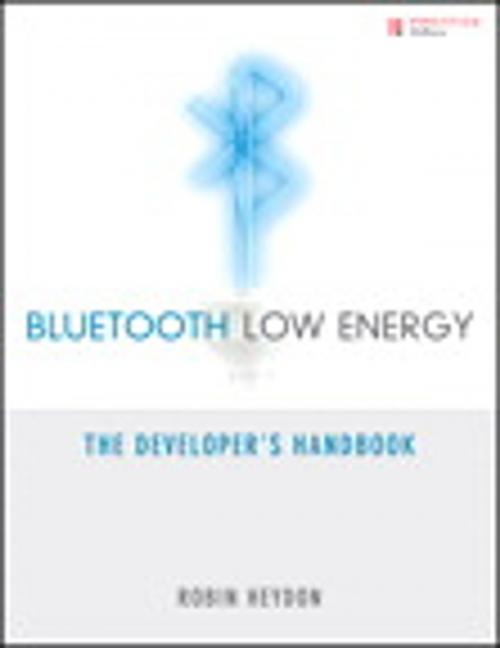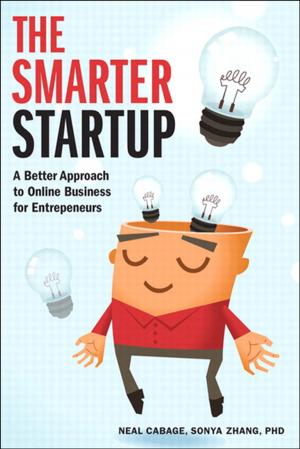Bluetooth Low Energy: The Developer's Handbook
The Developer's Handbook
Nonfiction, Computers, Networking & Communications, Electronic Data Interchange, Science & Nature, Technology, Telecommunications| Author: | Robin Heydon | ISBN: | 9780132888400 |
| Publisher: | Pearson Education | Publication: | October 26, 2012 |
| Imprint: | Prentice Hall | Language: | English |
| Author: | Robin Heydon |
| ISBN: | 9780132888400 |
| Publisher: | Pearson Education |
| Publication: | October 26, 2012 |
| Imprint: | Prentice Hall |
| Language: | English |
A radical departure from conventional Bluetooth technology, Bluetooth low energy (BLE) enables breakthrough wireless applications in industries ranging from healthcare to transportation. Running on a coin-sized battery, BLE can operate reliably for years, connecting and extending everything from personal area network devices to next-generation sensors. Now, one of the standard’s leading developers has written the first comprehensive, accessible introduction to BLE for every system developer, designer, and engineer.
Robin Heydon, a member of the Bluetooth SIG Hall of Fame, has brought together essential information previously scattered through multiple standards documents, sharing the context and expert insights needed to implement high-performance working systems. He first reviews BLE’s design goals, explaining how they drove key architectural decisions, and introduces BLE’s innovative usage models. Next, he thoroughly covers how the two main parts of BLE, the controller and host, work together, and then addresses key issues from security and profiles through testing and qualification. This knowledge has enabled the creation of Bluetooth Smart and Bluetooth Smart Ready devices.
This guide is an indispensable companion to the official BLE standards documents and is for every technical professional and decision-maker considering BLE, planning BLE products, or transforming plans into working systems.
Topics Include
- BLE device types, design goals, terminology, and core concepts
- Architecture: controller, host, applications, and stack splits
- Usage models: presence detection, data broadcasting, connectionless models, and gateways
- Physical Layer: modulation, frequency band, radio channels, power, tolerance, and range
- Direct Test Mode: transceiver testing, hardware interfaces, and HCI
- Link Layer: state machine, packets, channels, broadcasting, encryption, and optimization
- HCI: physical/logical interfaces, controller setup, and connection management
- L2CAP: channels and packet structure, and LE signaling channels
- Attributes: grouping, services, characteristics, and protocols
- Security: pairing, bonding, and data signing
- Generic Access Profiles: roles, modes, procedures, security modes, data advertising, and services
- Applications, devices, services, profiles, and peripherals
- Testing/qualification: starting projects, selecting features, planning, testing, compliance, and more
A radical departure from conventional Bluetooth technology, Bluetooth low energy (BLE) enables breakthrough wireless applications in industries ranging from healthcare to transportation. Running on a coin-sized battery, BLE can operate reliably for years, connecting and extending everything from personal area network devices to next-generation sensors. Now, one of the standard’s leading developers has written the first comprehensive, accessible introduction to BLE for every system developer, designer, and engineer.
Robin Heydon, a member of the Bluetooth SIG Hall of Fame, has brought together essential information previously scattered through multiple standards documents, sharing the context and expert insights needed to implement high-performance working systems. He first reviews BLE’s design goals, explaining how they drove key architectural decisions, and introduces BLE’s innovative usage models. Next, he thoroughly covers how the two main parts of BLE, the controller and host, work together, and then addresses key issues from security and profiles through testing and qualification. This knowledge has enabled the creation of Bluetooth Smart and Bluetooth Smart Ready devices.
This guide is an indispensable companion to the official BLE standards documents and is for every technical professional and decision-maker considering BLE, planning BLE products, or transforming plans into working systems.
Topics Include
- BLE device types, design goals, terminology, and core concepts
- Architecture: controller, host, applications, and stack splits
- Usage models: presence detection, data broadcasting, connectionless models, and gateways
- Physical Layer: modulation, frequency band, radio channels, power, tolerance, and range
- Direct Test Mode: transceiver testing, hardware interfaces, and HCI
- Link Layer: state machine, packets, channels, broadcasting, encryption, and optimization
- HCI: physical/logical interfaces, controller setup, and connection management
- L2CAP: channels and packet structure, and LE signaling channels
- Attributes: grouping, services, characteristics, and protocols
- Security: pairing, bonding, and data signing
- Generic Access Profiles: roles, modes, procedures, security modes, data advertising, and services
- Applications, devices, services, profiles, and peripherals
- Testing/qualification: starting projects, selecting features, planning, testing, compliance, and more













![Cover of the book [digital] Visual Effects and Compositing by Robin Heydon](https://www.kuoky.com/images/2014/october/300x300/9780133807240-vU6B_300x.jpg)

